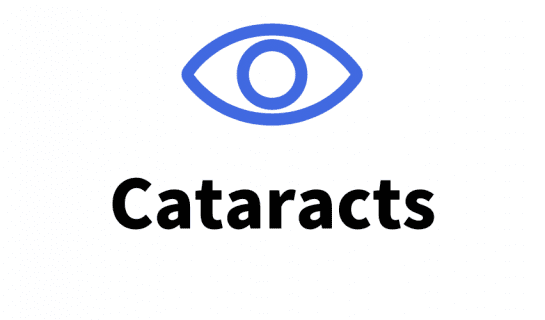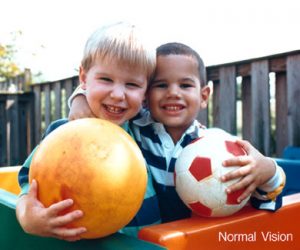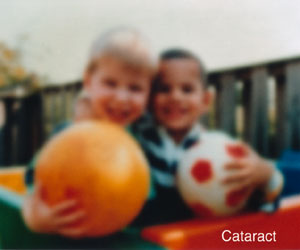Cataracts

What are Cataracts?
Cataracts may affect one or both eyes (unilateral cataracts and bilateral cataracts respectively). A Cataract is when the lens of the eye becomes clouded. The lens sits behind the iris (coloured part of the eye) but ahead of the retina. Cataracts occur when there are changes in the way the cells of the lens and their water conten are arranged. This results in light not passing directly through the lens which causes clouded vision. Over time cloudy patches in the visual field increase, eventually causing blindness. There are two types. The more commonly occurring ‘Age related Cataracts’ and the less common ‘Childhood / congenital cataracts’. It is expected for older age groups to develop cataracts at some point. However it can develop early depending on various risk factors (see below). Childhood cataracts are categorised into two types;
- Congenital cataracts (cataracts present at birth or shortly after)
- Developmental / infantile / juvenile cataracts (diagnosed in older babies and children)
Symptoms of Cataracts:
Sight loss and symptoms tend to develop and become apparent over time. So you are unlikely to be aware of the presence of cataracts early on.
Symptoms include;
- Misty or cloudy vision
- Increased light sensitivity
- Finding it harder to see in low light
- Colours look faded
- Eye pain is usually only felt if you have another eye condition or if the cataracts has reached an advanced stage
- Thinking that your eye glasses are dirty when they are not

Scene as someone fully sighted would see it.

Scene as someone with Cataracts might see it.
How are Cataracts diagnosed:
An optician runs a series of eye tests including a visual acuity exam to measure your sight at various distances. If the optician thinks that a person might have cataracts, they will refer the client to a specialist to investigate and discuss further tests and treatment.
Babies are routinely screened for cataracts within 72 hours of birth and again when they are 6-8 weeks old. If congenital cataracts are suspected from the new born examination, a specialist will be in contact within two weeks. If it is suspected from the 6-8 week examination, then the specialist will be in contact within 11 weeks of birth. Sometimes symptoms may develop after these tests and can be hard to ascertain in children. So parents should pay extra attention to any signs of poor sight and make contact with the relevant clinic immediately. Especially since long term sight issues may be avoided with earlier treatment. Some notable signs of Cataracts are wobbling eyes and a squint, where the eyes point in different directions. Others may include; the child’s eyes / pupil taking on an unconventional colour (e.g. whitish grey), seeing your child struggle with glaring light or with visually following people or objects.
Treatments for / management of Cataracts:
Cataracts can be removed via surgery in which the deteriorated lens is removed and replaced by an artificial lens (intra ocular lens-IOL), usually made of plastic or siliconr. This is currently the only proven effective treatment. If a person has cataracts in both eyes then normally one eye would be treated first and the other would be operated on after the recovery process of the first procedure. This is a low risk surgery but details should be discussed with your specialist. In early stages of cataracts where symptoms are mild, your sight can be helped with brighter lights and stronger glasses but this is only a temporary fix. The eventual requirement for surgery is usually inevitable. If you have cataracts but still meet the official ‘visual standards for driving’ (see the government website link below) and are not experiencing an increased sensitivity to glare, you are not required to inform DVLA of having cataracts past or present.
For babies and small children it is more common (especially when both eyes are affected) to prescribe external visual aids like contact lenses or glasses after surgery to compensate for vision problems caused by the removal of the lens (instead of replacing the lens with an IOL). Ophthalmologists recommend this particularly for babies under 12 months of age as IOL insertions may cause further complications and increase the risk of requiring further surgery. In fact even when the presence of cataracts is identified in babies / small children, any surgery is delayed until the child experiences sight loss in order to lower such complications. As childhood cataracts is rare, it is difficult to predict how much of a child’s vision will improve after treatment. Many are likely to have reduced vision in the affected eye(s) even after treatment but will be able to attend mainstream school and live full lives. Your child will have regular routine check ups for monitoring purposes and any potential further action required (e.g. adjusting strength of contact lenses / glasses, further medical procedures, etc.). The NHS website provides various guidance and details on childhood cataracts, its treatment, management and medical procedures.
Prevention / risk factors:
Most people tend to develop cataracts over the age of 65 while a significant number are affected in their 40s-50s. Cataracts can also affect people of younger age groups (including children) but this is less common. The exact cause of cataracts is currently unknown. Risk factors include; having diabetes, traumatic eye injuries, some prescription drugs (e.g. steroids), smoking, family history of cataracts, drinking too much alcohol, and having high myopia (being very short sighted). Surgery for a retinal problem will likely cause cataracts in the affected eye at some point in the future. People with learning disabilities are also more likely to develop cataracts. Thus, the same prevention measures for diabetes are recommended. For children it is essential that parents / guardians pay close attention to any signs of sight problems in their recently born babies / children and report to their GP promptly. Also all children under the age of 16 years are offered free sight tests every 2 years so naturally ensuring attendance to these would be beneficial.
Further information and Support:
Driving and cataracts:
